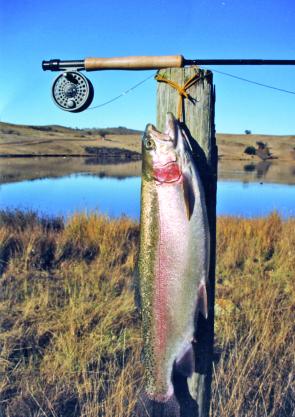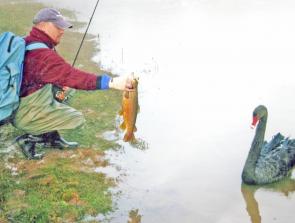The opening of the trout season is always a pleasant time in Canberra-Monaro country.
It's a time to renew old acquaintances from city and country and plan new trips, to reminisce over good times and to shake our heads or chuckle when reminded of past disasters.
It's a refreshing change, fishing streams instead of lakes. Streams have an excitement about them that lakes can rarely match.
There is the anticipation of what's around the next bend, the next corner, of planting a fly in exactly the right spot – a riffle, a rapid, a long slow drift, a deep eddy or a swirl around a rock or protruding tree trunk.
There’s the pleasure of seeing a fish flash in the coloured early-season water, the tingle of delight when the line tightens and a fish is hooked, then drawn to the bank and lifted gently from the snowmelt water. The delight in watching it pause, puzzled for few moments, after it is unhooked and released, before it swims away.
Lakes can't match that. Streams have structure, variation, differences, encouragement to continue fishing just that bit further, a bit longer each day.
Streams have character. And demands. You have to watch your back cast, because for a change there are shrubs, trees, grassy tufts, fences, rocks and other fly-snatchers behind you.
You have to be wary of livestock and remember how our old long-departed mate John Sautelle once lost an entire fly line when he accidentally wrapped it round the horns of a curious steer that had wandered up behind him in the gathering dusk.
You have to learn, too, the difference between the swirl of a rising fish and that of a curious platypus or a fish-stealing water rat. With the platypus you enjoy watching each other as you pass its patch of river, listening to the slap of its tail as it dives to look for a mudeye or yabby.
With the water rat it's different. The first thing you do is check to see if it has pinched any fish you have put aside to take home. The second is to check if it has knocked off your lunch.
Streams have it all over lakes. The fish aren't usually as big but they are certainly more testing, more interesting and more demanding of your stream craft. And that's what makes it so enjoyable.
There will also be a new crop of fly casters this season. Each year before the season opens the Canberra Anglers Association holds a series of public casting classes on the lawns of Old Parliament House. It's a delightful location and a big crowd always participates.
The lessons are held on two consecutive Sundays, during which the newcomers are taught the basics of casting and get some advice about streamcraft. On the third Sunday, they progress to the Eucumbene Trout Farm to try their new-found skills on trout in a stocked lake.
The fish are quite wild and properly testing opponents but each year most students manage to land at least one fish each. It's an enormous pleasure to see the delight of the person hooking and landing that first fish. You know straight away they’re hooked for life.
Teach a person to fly fish and they will delight in fishing for the rest of their life and in passing on that knowledge to others.
And in case you missed the chance to learn, I teach in Canberra every Saturday and it's free. Give me a ring and I will look after you. You don't need to bring any gear as I can supply all that.
The drought, now about eight years long, has meant the end of many previously valuable trout streams. Rainfall runoff in the region is down 63% on the long-term average and in the past year is down a staggering 74% – one hell of a drought.
While many of the lower-country streams are no longer worth fishing, some of the higher rivers are well worth a look.
There have been good flows and pleasingly high numbers of fish in some of the larger streams such as the upper Murrumbidgee, Eucumbene, Thredbo, Tumut, Goodradigbee and Delegate, and in some of the smaller streams.
A number of streams will have fishable water early in the season but decline later and the fish have to migrate back to the nearest lake or a larger, more-permanent river.
Thankfully there is a lot of snow in the high country this year and that will provide short-term meltwater to many of the streams and longer-term seepage.
That means we should have some good stream fishing until at least early next year, or longer in some of the waters.
The new season also is an opportunity to check your gear and to find out what maintenance you should have been doing during Winter.
You pick up your rod and find, yes, that guide that was loose last year finally has fallen off. And you can't find it so it's off to the nearest tackle shop for repair. Delay number one.
You check your waders and, sure enough, there is a pinhole or three and you can't find where. You just know that icy cold water is chilling your legs when you wade in the stream and unless you have a nasty bladder malfunction you were unaware of, that really is a leak.
So you retire to the shower, fill your waders and tiny globules of water leak out at the very spots you are now going to have to treat with Aquaseal – after you buy some. Delay number two.
When it sets you can go fishing again but now you find the little chewy beasties have been in your fly box during Winter because you forgot to put a mothball in there and half your flies are in bits. Delay number three.
Having replaced your flies with expensive bought ones or satisfyingly creative and cheaper ones you tied yourself, you now find yourself ready to venture forth. Welcome to the new season.
Despite my love of streams, lakes are still the backbone of our fishing. They are big, permanent, snow-fed and open all year round.
This year, though, they are still low as the drought takes its toll and water is bled off for hydro power production, irrigation, environmental flows and domestic use. At the time of writing Eucumbene is 13%, Jindabyne 51% and Tantangara 11%. By the time all the snow melts you can expect maximum levels of about 23%, 69% and 14%, irrespective of how much rain we get.
That's not a lot of water but certainly enough to provide some satisfying fishing, especially when you realise that in Jindabyne and Eucumbene the water will be rising over new ground and that always means better fishing because of the food goodies being flushed out of the soil.
Boaters, too, should fare better this year. The new boat ramp at Anglers Reach at Eucumbene provides all-weather, all-level access to the lake and already is greatly appreciated by anglers.
That means you can now launch at Anglers Reach, Old Adaminaby, Buckenderra and the dam wall, as well as from hard ground at various points around the lake.
That provides access to some great trolling, lure casting, bait fishing and fly water. And with most of the browns and a fair proportion of the rainbows back from spawning and hungry, we can look forward to some great fishing.
Reads: 1438
With plentiful food early in the season, rainbows commonly are in peak condition and superb for the table.

Stream fish are usually smaller than lake fish but more testing opponents and more interesting to catch.

Students at the Canberra Anglers Association pre-season fly casting classes on the lawns of Old Parliament House, taking their first steps in a new fishing career.

Communing with the local wildlife is one of the extra pleasures of trout fishing.




